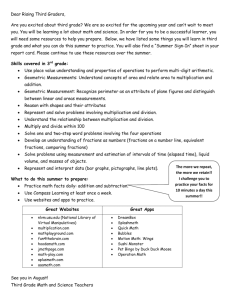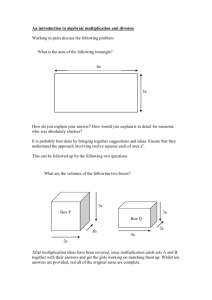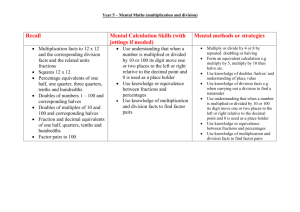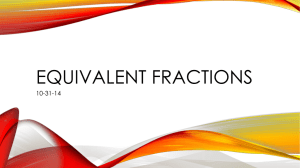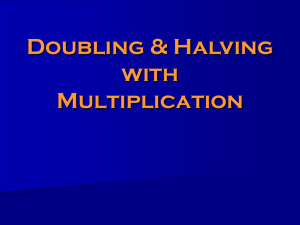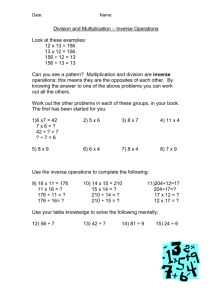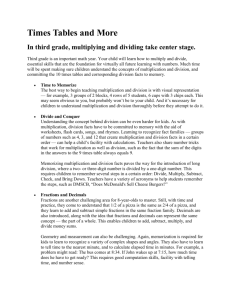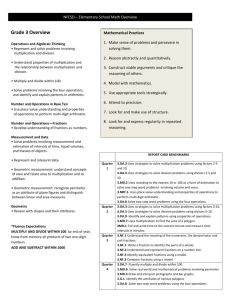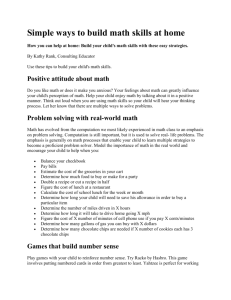Elaborations: Number - Multiplication and Division
advertisement
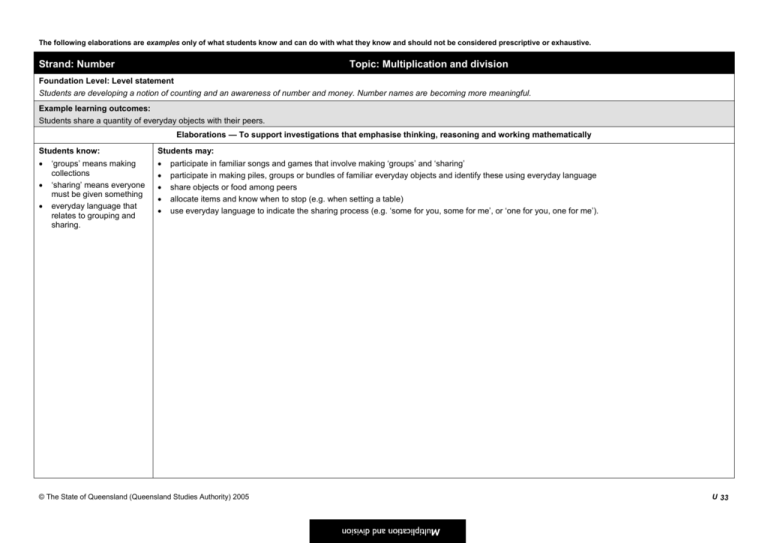
The following elaborations are examples only of what students know and can do with what they know and should not be considered prescriptive or exhaustive. Strand: Number Topic: Multiplication and division Foundation Level: Level statement Students are developing a notion of counting and an awareness of number and money. Number names are becoming more meaningful. Example learning outcomes: Students share a quantity of everyday objects with their peers. Elaborations — To support investigations that emphasise thinking, reasoning and working mathematically Students know: Students may: ‘groups’ means making collections ‘sharing’ means everyone must be given something everyday language that relates to grouping and sharing. participate in familiar songs and games that involve making ‘groups’ and ‘sharing’ participate in making piles, groups or bundles of familiar everyday objects and identify these using everyday language share objects or food among peers allocate items and know when to stop (e.g. when setting a table) use everyday language to indicate the sharing process (e.g. ‘some for you, some for me’, or ‘one for you, one for me’). © The State of Queensland (Queensland Studies Authority) 2005 U 33 The following elaborations are examples only of what students know and can do with what they know and should not be considered prescriptive or exhaustive. Level 1: Level statement Students are developing a sense of number by knowing number names and counting in sequence. They recognise, compare, order and represent small whole numbers and use concrete materials to explore the concept of parts of a whole. They are developing an awareness of the cost of goods and recognise and represent notes and coins. Students identify and distinguish between situations that require them to add or subtract, to share equally or to create equal groups. Core learning outcome: N 1.3 Students identify and describe equal groups and equal sharing within everyday situations. Elaborations — To support investigations that emphasise thinking, reasoning and working mathematically Core content Students know: Students may: Multiplication equal means the same how to distinguish between equal and not equal groups ways to make equal groups how to describe equal groups how to describe equal sharing. identify a collection as a group explain ways of making equal groups make groups of equal numbers for numbers up to 10 and describe how the groups are equal identify ways to check that groups are equal explain ways of sharing a collection to make equal groups share a collection equally into a given number of groups and describe how the groups are equal identify ways to check that each group is the same. models and language set (equal groups) Division models and language partition (sharing equally) Connections Fractions and proportion Mental computation strategies Multiplication Division Computation methods At each level, investigations should occur in a range of contexts. For example, students could investigate: groups of given numbers formed for games and musical activities how to deal cards resources shared equally lolly bags filled with combinations of different lollies. © The State of Queensland (Queensland Studies Authority) 2005 U 35 The following elaborations are examples only of what students know and can do with what they know and should not be considered prescriptive or exhaustive. Level 2: Level statement Students demonstrate their developing number sense by comparing, ordering and representing whole numbers to 999 and understanding that the value of a digit in a number determines its place value. They understand that a whole can be made up of equal parts and use concrete materials to represent halves and quarters. When using money to purchase goods, they tender different combinations of notes and coins. Students are beginning to recall or work out some addition, subtraction and multiplication number facts. They use a range of computation methods, including mental, written and calculator, to solve problems. Core learning outcome: N 2.3 Students identify and solve multiplication and division problems involving whole numbers, selecting from a range of computation methods, strategies and known number facts. Elaborations — To support investigations that emphasise thinking, reasoning and working mathematically Core content Students know: Students may: Multiplication how to distinguish between situations that require multiplication or division of whole numbers ways of representing multiplication problems ways of representing division problems the connections between multiplication and models for division mental computation strategies and computation methods for solving problems involving multiplication how to solve multiplication and division problems involving whole numbers how to recall some multiplication facts. identify whether a problem requires multiplication or division and give reasons for the decision use calculators and appropriate materials to demonstrate that skip counting (e.g. counting in 2s or 5s) can be used for multiplication represent arrays in different ways (e.g. using different materials or different arrays for the same number) work out different representations of equal groups or equal sharing make connections between models for multiplication and division (e.g. represent groups on a number line) relate multiplication facts to division use a calculator to demonstrate the connections between multiplication and division work out relevant number facts (to x 9) using jottings as required recall number facts select and compare different computation methods that could be used to solve a problem explain computation methods use different ways to check the reasonableness of answers (e.g. calculator or alternative methods) create and solve simple sharing problems and simple problems requiring multiplication. models and language set (equal groups) area (arrays) linear (number lines) multiplication facts recall 2s, 4s, 5s and 1s to x 9 Division models and language partition (sharing equally) quotition (equal groups) Connections inverse (backtracking) division undoes multiplication multiplication undoes division Fractions and proportion Mental computation strategies Multiplication to work out basic facts skip counting doubles double doubles turnarounds (commutativity) student-generated generalisations about multiplication Division © The State of Queensland (Queensland Studies Authority) 2005 U 36 The following elaborations are examples only of what students know and can do with what they know and should not be considered prescriptive or exhaustive. Computation methods mental computations exact written recordings language for multiplication (groups of, rows of, jumps of) language for division (share between, share) calculators symbols for multiplication (x) and division () At each level, investigations should occur in a range of contexts. For example, students could investigate: organisation of items for a display, such as arranging works of art onto display boards organisation of marching teams or marching bands for a demonstration ways of dividing a large collection or quantity into smaller portions, such as food portions, lollies into bags for sale catering for food stalls at fetes. © The State of Queensland (Queensland Studies Authority) 2005 U 37 The following elaborations are examples only of what students know and can do with what they know and should not be considered prescriptive or exhaustive. Level 3: Level statement Students compare, order and represent whole numbers to 9 999, common and decimal fractions and recognise the value of each digit. They tender appropriate amounts of money for cash transactions and identify other methods of paying for goods and services. Students recall or work out all addition, subtraction and multiplication number facts and some division facts. They use a range of computation methods, including mental, written and calculator, to solve problems that involve whole numbers and decimal fractions in context. Core learning outcome: N 3.3 Students identify and solve multiplication and division problems involving whole numbers and decimal fractions in context, selecting from a range of computation methods, strategies and known number facts. Elaborations — To support investigations that emphasise thinking, reasoning and working mathematically Core content Students know: Students may: Multiplication models and language combinations of whole numbers and decimal fractions in context multiplication facts recall 2s, 4s, 5s and 1s to x 9 work out remaining facts how to distinguish between multiplication and division in situations involving whole numbers and decimal fractions in context ways of representing multiplication and division problems multiplication and related division number facts connections between multiplication and division mental computation strategies and computation methods for solving problems involving whole numbers and decimal fractions in context how to solve multiplication and division problems involving whole numbers and decimal fractions in context how to use the inverse relationship between multiplication and division to solve problems how to recall or work out multiplication facts to x 9 how to recall or work out division facts. identify whether a problem requires multiplication or division and give reasons for the decision explain whether an exact or approximate solution is required describe ways to represent a problem make the whole numbers and decimal fractions manageable, as necessary, and explain the process e.g. make to the nearest thousand, nearest one select from a range of computation methods, strategies and known number facts to solve a problem and justify choice/s explain connections between multiplication and division use backtracking (inverse), where appropriate, to find missing factors determine the reasonableness of an answer and check using a calculator or alternative method apply mental computation strategies to extend basic facts to larger numbers identify and describe possible computation methods and strategies appropriate for a particular problem. © The State of Queensland (Queensland Studies Authority) 2005 Division models and language partition (sharing equally) quotition (equal groups) involving single-digit whole number divisors division facts recall 2s, 4s, 5s and 1s work out remaining facts Connections inverse (backtracking) related multiplication and division facts missing factor Fractions and proportion reducing numbers by ½ enlarging numbers by multiples of ½ (e.g. 1½) U 38 The following elaborations are examples only of what students know and can do with what they know and should not be considered prescriptive or exhaustive. Mental computation strategies Multiplication to work out basic facts double, double doubles (x 8) build up, build down to known facts turnarounds (commutativity) extend basic facts strategies to larger numbers student-generated generalisations about multiplication Division related multiplication facts extend basic facts to other numbers student-generated generalisations about division Computation methods mental computations exact approximate written recordings student-generated traditional methods (single-digit whole number multipliers and divisors) calculators/computers link and with and / symbols At each level, investigations should occur in a range of contexts. For example, students could investigate: payments for recurring events, such as comparisons between a season pass and weekly attendance at events costs for groups to attend performances or events (per capita payments) how to share class resources how to order beverages or craft supplies in bulk group bookings for outings. © The State of Queensland (Queensland Studies Authority) 2005 U 39 The following elaborations are examples only of what students know and can do with what they know and should not be considered prescriptive or exhaustive. Level 4: Level statement Students compare and order whole numbers and common and decimal fractions. They identify fractions expressed in different ways and make connections between common fractions, decimal fractions and percentages. They identify a range of factors such as advertising, discounts and methods of payment that may influence financial decisions. Students recall all addition, subtraction, multiplication and division number facts. They use a range of computation methods to solve problems that involve whole numbers, common and decimal fractions, percentages and rates. Core learning outcome: N 4.3 Students identify and solve multiplication and division problems involving whole numbers, decimal fractions, common fractions, percentages and rates, selecting from a range of computation methods, strategies and known number facts. Elaborations — To support investigations that emphasise thinking, reasoning and working mathematically Core content Students know: Students may: Multiplication how to distinguish between multiplication and division in situations involving whole numbers, decimal fractions, common fractions, percentages and rates multiplication and division facts different representations of division mental computation strategies and computation methods and strategies for solving problems involving whole numbers, decimal fractions, common fractions, percentages and rates how to solve multiplication and division problems involving whole numbers, decimal fractions and common fractions how to use the inverse relationship between multiplication and division to solve problems links between common fractions, decimal fractions and percentages identify whether a problem requires multiplication or division and give reasons for the decision explain whether an exact or approximate solution is required represent the problem in a number of ways make generalisations about rules related to multiplication and division identify and describe the key components of common fractions determine equivalent forms of key percentages, unit fractions (common fractions with a numerator of 1) and decimal fractions as required to assist calculations (e.g. multiply by 0.25 or ¼ to find 25% of an amount) identify situations that involve percentages solve problems selecting from a range or combination of computation methods, strategies and known number facts and give reasons for the selection identify situations that involve rates and describe the rate in terms of unit per unit select an appropriate multiplication or division method or strategy to solve problems involving rates use backtracking (inverse) where appropriate to find unknown values or to check answers determine the reasonableness of an answer and check using a calculator or alternative method. © The State of Queensland (Queensland Studies Authority) 2005 whole numbers common fractions decimal fractions to hundredths recall multiplication facts to 9 x 9 Division whole numbers decimal fractions to hundredths recall division facts Connections relationship between division and common fractions inverse (backtracking) Fractions and proportion Fractions unit fractions as operators (e.g. ⅛ of 120) vinculum for division (horizontal line separating the numerator from the denominator) links between key percentages, unit fractions and decimal fractions Rates simple everyday rates such as kilometres per hour U 40 The following elaborations are examples only of what students know and can do with what they know and should not be considered prescriptive or exhaustive. how to solve problems involving percentages rates represent relationships between quantities how to solve problems involving rates. Mental computation strategies for beyond basic facts extensions of all multiplication and division facts doubling halving student-generated place value adjusting numbers build up, build down generalisations about multiplication and division Computation methods mental computations exact approximate written recordings student-generated traditional methods (one- and two-digit multipliers; single-digit whole number divisors) formats for recording division 13/4 4 13 13 4 calculators, computers At each level, investigations should occur in a range of contexts. For example, students could investigate: discounts on purchases election results in terms of the percentage of votes for candidates in an electorate immigration statistics rates of travel for various modes of transport the speed at which balls, or other sporting implements, travel interest rates for various types of bank accounts domestic water consumption. © The State of Queensland (Queensland Studies Authority) 2005 U 41 The following elaborations are examples only of what students know and can do with what they know and should not be considered prescriptive or exhaustive. Level 5: Level statement Students compare and order positive and negative integers and explain and record index notation. They interpret and use conventions for expressing rates and ratios. They identify methods of saving and investigate the factors affecting debit and credit transactions. They understand that the purchase of goods and services may attract fees or charges. Students use a range of computation methods to solve problems that involve positive rational numbers, rates, ratios and direct proportions. Core learning outcome: N 5.3 Students identify and solve multiplication and division problems involving positive rational numbers, rates, ratios and direct proportions, using a range of computation methods and strategies. Elaborations — To support investigations that emphasise thinking, reasoning and working mathematically Core content Students know: Students may: Multiplication how to distinguish between multiplication and division in situations involving positive rational numbers, rates, ratios and direct proportions how to identify different representations for ratios and direct proportion to solve problems rates represent relationships between unlike quantities ratios represent relationships between like quantities direct proportion is the equivalence of two ratios the similarities and differences between rates, ratios and direct proportions mental computation strategies and computation methods for solving problems involving positive rational numbers, rates, ratios and direct proportions how to use the inverse relationship between multiplication and division to solve problems how to solve problems involving positive rational numbers decide if an exact or approximate answer is required select and justify computation methods and strategies used to solve problems explain the difference between rates and ratios and explain ‘rate’ as being the relationship between ‘unlike’ units explain ‘ratio’ as being the relationship between ‘like’ units explain ‘direct proportion’ as being the equivalence of two ratios (e.g. 1:2 and 2:4 or 2:3 and 4:6) explain the difference between ratios and direct proportion record ratios for different situations using the appropriate symbol use the relationship between units to calculate quantities, such as cost, number of items, or length of timber, and involve percentages as appropriate determine and record rates for situations where the rate is unknown pose and solve problems involving rational numbers, rates, ratios and direct proportions check reasonableness of solutions. © The State of Queensland (Queensland Studies Authority) 2005 positive rational numbers whole numbers common fractions decimal fractions numbers with indices Division positive rational numbers whole numbers common fractions decimal fractions Connections inverse (backtracking) Fractions and proportion Fractions percentages, common fractions, decimal fractions Rates calculations involving everyday rates (e.g. mobile phone charges) Ratio simple everyday ratios (e.g. 1 part juice concentrate to 4 parts water) symbol for ratio ( : ) Direct proportion calculations with direct proportion (including graphical representations) U 42 The following elaborations are examples only of what students know and can do with what they know and should not be considered prescriptive or exhaustive. how to solve problems involving rates how to solve problems involving ratios how to solve problems involving direct proportions. Mental computation strategies relevant to whole numbers, common and decimal fractions, percentages links student-preferred generalisations about multiplication and division Computation methods mental computations exact approximate written recordings student-generated traditional methods calculators, computers At each level, investigations should occur in a range of contexts. For example, students could investigate: financial transactions involving percentage discounts measurement situations involving area and volume scale for plans and maps relationships between quantities represented on graphs recipes that require an increase or decrease in the quantities of ingredients used handicap systems in a variety of sports. © The State of Queensland (Queensland Studies Authority) 2005 U 43 The following elaborations are examples only of what students know and can do with what they know and should not be considered prescriptive or exhaustive. Level 6: Level statement Students compare and order rational numbers and use scientific notation as a short-hand method of representing very large or very small numbers. They develop personal plans, consider financial options and monitor financial situations using available information. Students use a range of computation methods and strategies to solve problems that involve rational numbers, rates, ratios and direct and inverse proportions. Core learning outcome: N 6.3 Students identify and solve multiplication and division problems involving rational numbers, rates, ratios and direct and inverse proportions using a range of computation methods and strategies. Elaborations — To support investigations that emphasise thinking, reasoning and working mathematically Core content Students know: Students may: Multiplication how to distinguish between situations that require multiplication, division or both and involve rational numbers, rates, ratios, direct and inverse proportions inverse proportion represents one quantity increasing while the other decreases by the same factor mental computation strategies and computation methods for solving problems involving rational numbers, rates, ratios and direct and inverse proportions how to solve problems involving rational numbers how to solve problems involving rates how to solve problems involving ratios how to solve problems involving direct and inverse proportions. decide if an exact or approximate answer is required explain inverse proportion as being when the value of one quantity increases as the quantity of the other variable decreases by the same factor explain the difference between direct and inverse proportion select and justify computation methods and strategies used to solve problems check reasonableness of solutions pose and solve problems involving rational numbers, rates, ratio, direct and inverse proportions. rational numbers negative numbers (with calculator) Division Connections inverse (backtracking) Fractions and proportion Fractions fractional percentages of numbers Rates comparisons of rates expressed in various forms Ratio and proportion as direct proportion as inverse proportion Mental computation strategies relevant to rational numbers generalisations about multiplication and division Computation methods mental computations exact approximate written recordings student-generated traditional methods © The State of Queensland (Queensland Studies Authority) 2005 calculators, computers U 44 The following elaborations are examples only of what students know and can do with what they know and should not be considered prescriptive or exhaustive. At each level, investigations should occur in a range of contexts. For example, students could investigate: media claims involving the interpretation of rates and ratios from survey and census data sporting statistics, such as run rates in cricket, split times in swimming, track events or cycling Duckworth-Lewis method of determining the winner of a cricket match specific fuel consumption with variations in speed relationships between quantities represented on graphs relationship between speed of a skateboard or bicycle and the time taken to travel a distance the relationship between fuel quantity remaining in the fuel tanks of an aircraft and the time spent airborne converting imperial measures, such as in tool sizes, to metric measures scientific laws, such as for energy or gravity daily credit card interest rates requirements for sustainability of populations. © The State of Queensland (Queensland Studies Authority) 2005 U 45
